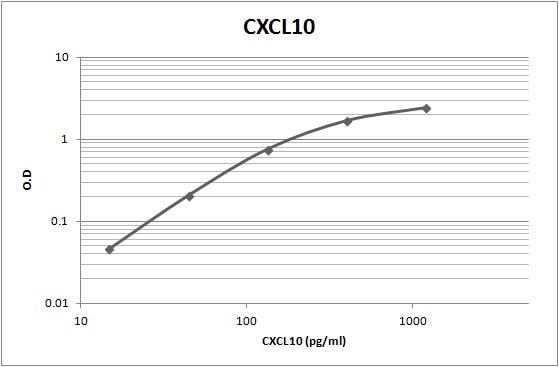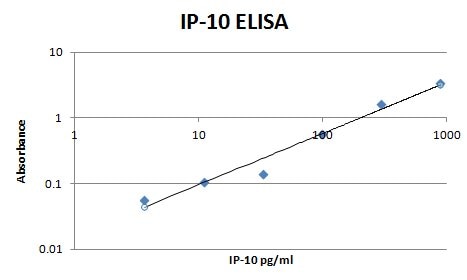Human CXCL10/IP‑10/CRG‑2 Biotinylated Antibody Summary
Applications
Human CXCL10/IP-10 Sandwich Immunoassay
Please Note: Optimal dilutions should be determined by each laboratory for each application. General Protocols are available in the Technical Information section on our website.
Preparation and Storage
- 12 months from date of receipt, -20 to -70 °C as supplied.
- 1 month, 2 to 8 °C under sterile conditions after reconstitution.
- 6 months, -20 to -70 °C under sterile conditions after reconstitution.
Background: CXCL10/IP-10/CRG-2
CXCL10 was originally identified as an IFN-gamma -inducible gene in monocytes, fibroblasts, and endothelial cells. It has since been shown that CXCL10 mRNA is also induced by LPS, IL-1 beta, TNF-alpha, IL-12, and viruses. Additional cell types that have been shown to express CXCL10 include activated T-lymphocytes, splenocytes, keratinocytes, osteoblasts, astrocytes, and smooth muscle cells. CXCL10 is also expressed in psoriatic and lepromatous lesions of skin. The mouse homologue of human CXCL10, CRG-2, has been cloned and shown to share approximately 67% amino acid (aa) sequence identity with human CXCL10. Human CXCL10 cDNA encodes a 98 aa residue precursor protein with a 21 aa residue signal peptide that is cleaved to form the 77 aa residue secreted protein. The amino acid sequence of CXCL10 identified the protein as a member of the chemokine alpha subfamily that lacks the ELR domain. CXCL10 has been shown to be a chemoattractant for activated T-lymphocytes. CXCL10 has been reported to be a potent inhibitor of angiogenesis and to display a potent thymus-dependent anti-tumor effect. A chemokine receptor specific for CXCL10 and MIG has been cloned and shown to be highly expressed in IL-2-activated T-lymphocytes.
Product Datasheets
Citations for Human CXCL10/IP‑10/CRG‑2 Biotinylated Antibody
R&D Systems personnel manually curate a database that contains references using R&D Systems products. The data collected includes not only links to publications in PubMed, but also provides information about sample types, species, and experimental conditions.
19
Citations: Showing 1 - 10
Filter your results:
Filter by:
-
Immune response dynamics in COVID-19 patients to SARS-CoV-2 and other human coronaviruses
Authors: R Ravindran, C McReynolds, J Yang, BD Hammock, A Ikram, A Ali, A Bashir, T Zohra, WLW Chang, DJ Hartigan-O, HH Rashidi, IH Khan
PLoS ONE, 2021-07-09;16(7):e0254367.
Species: Human
Sample Types: Plasma
Applications: ELISA Detection -
Immune-Stimulatory Effects of Curcumin on the Tumor Microenvironment in Head and Neck Squamous Cell Carcinoma
Authors: C Kötting, L Hofmann, R Lotfi, D Engelhardt, S Laban, PJ Schuler, TK Hoffmann, C Brunner, MN Theodoraki
Cancers, 2021-03-16;13(6):.
Species: Human
Sample Types: Cell Culture Supernates
Applications: ELISA Detection -
Cervico-Vaginal Inflammatory Cytokine and Chemokine Responses to Two Different SIV Immunogens
Authors: Nikki P. L. Toledo, Hongzhao Li, Robert W. Omange, Tamara G. Dacoba, Jose Crecente-Campo, Dane Schalk et al.
Frontiers in Immunology
-
Induction of Chemokines by Hepatitis C Virus Proteins: Synergy of the Core Protein with Interleukin-1 beta and Interferon-gamma in Liver Bystander Cells
Authors: Sara Abouelasrar Salama, Mieke Gouwy, Alexandra De Zutter, Noëmie Pörtner, Lotte Vanbrabant, Nele Berghmans et al.
Journal of Interferon & Cytokine Research
-
Association of MIF, but not type I interferon-induced chemokines, with increased disease activity in Asian patients with systemic lupus erythematosus
Sci Rep, 2016-07-25;6(0):29909.
Species: Human
Sample Types: Serum
-
Allergen challenge in vivo alters rhinovirus-induced chemokine secretion from human airway macrophages.
Authors: Karta, Maya R, Wickert, Lisa E, Curran, Colleen, Gavala, Monica L, Denlinger, Loren C, Gern, James E, Bertics, Paul J
J Allergy Clin Immunol, 2014-02-14;133(4):1227-30.
Species: Human
Sample Types: Whole Cells
Applications: ELISA Development (Detection) -
Human rhinovirus-induced ISG15 selectively modulates epithelial antiviral immunity.
Authors: Zaheer R, Wiehler S, Hudy M, Traves S, Pelikan J, Leigh R, Proud D
Mucosal Immunol, 2014-01-22;7(5):1127-38.
Species: Human
Sample Types: Cell Culture Supernates
Applications: ELISA Development (Detection) -
Upregulation of human cytomegalovirus by HIV type 1 in human lymphoid tissue ex vivo.
Authors: Biancotto A, Iglehart SJ, Lisco A, Vanpouille C, Grivel JC, Lurain NS, Reichelderfer PS, Margolis LB
AIDS Res. Hum. Retroviruses, 2008-03-01;24(3):453-62.
Species: Human
Sample Types: Cell Culture Supernates
Applications: Luminex Development -
Fluorescence single-molecule counting assays for high-sensitivity detection of cytokines and chemokines.
Authors: Qui H, Ferrell EP, Nolan N, Phelps BH, Tabibiazar R, Whitney DH, Naelfski EA
Clin. Chem., 2007-11-01;53(11):2010-2.
Species: Human
Sample Types: Plasma
Applications: ELISA Development -
Effect of serum content and diluent selection on assay sensitivity and signal intensity in multiplex bead-based immunoassays.
Authors: Pfleger C, Schloot N, ter Veld F
J. Immunol. Methods, 2007-10-22;329(1):214-8.
Species: Human
Sample Types: Serum
Applications: Luminex Development -
Eotaxin-2 and colorectal cancer: a potential target for immune therapy.
Authors: Cheadle EJ, Riyad K, Subar D, Rothwell DG, Ashton G, Batha H, Sherlock DJ, Hawkins RE, Gilham DE
Clin. Cancer Res., 2007-10-01;13(19):5719-28.
Species: Human
Sample Types: Tissue Homogenates
Applications: ELISA Development -
Generation of Th1 and Th2 chemokines by human eosinophils: evidence for a critical role of TNF-alpha.
Authors: Liu LY, Bates ME, Jarjour NN, Busse WW, Bertics PJ, Kelly EA
J. Immunol., 2007-10-01;179(7):4840-8.
Species: Human
Sample Types: Cell Culture Supernates
Applications: ELISA Development -
Abnormal activation and cytokine spectra in lymph nodes of people chronically infected with HIV-1.
Authors: Biancotto A, Grivel JC, Iglehart SJ, Vanpouille C, Lisco A, Sieg SF, Debernardo R, Garate K, Rodriguez B, Margolis LB, Lederman MM
Blood, 2007-02-08;109(10):4272-9.
Species: Human
Sample Types: Cell Culture Supernates
Applications: Luminex Development -
HIV-1 pathogenesis differs in rectosigmoid and tonsillar tissues infected ex vivo with CCR5- and CXCR4-tropic HIV-1.
Authors: Grivel JC, Elliott J, Lisco A, Biancotto A, Condack C, Shattock RJ, McGowan I, Margolis L, Anton P
AIDS, 2007;21(10):1263-72.
Species: Human
Sample Types: Cell Culture Supernates
Applications: Luminex Development -
Increased expression of Th2-associated chemokines in bullous pemphigoid disease. Role of eosinophils in the production and release of these chemokines.
Authors: Gounni Abdelilah S, Wellemans V, Agouli M, Guenounou M, Hamid Q, Beck LA, Lamkhioued B
Clin. Immunol., 2006-06-16;120(2):220-31.
Species: Human
Sample Types: Cell Culture Supernates
Applications: ELISA Development -
Combination therapy: Synergistic suppression of virus-induced chemokines in airway epithelial cells.
Authors: Edwards MR, Johnson MW, Johnston SL
Am. J. Respir. Cell Mol. Biol., 2006-01-19;34(5):616-24.
Species: Human
Sample Types: Cell Culture Supernates
Applications: ELISA Development -
Rapid chemokine secretion from endothelial cells originates from 2 distinct compartments.
Authors: Oynebraten I, Bakke O, Brandtzaeg P, Johansen FE, Haraldsen G
Blood, 2004-03-25;104(2):314-20.
Species: Human
Sample Types: Cell Culture Supernates, Whole Cells
Applications: ELISA Development, ICC -
Imbalance in the expression of CXC chemokines correlates with bronchoalveolar lavage fluid angiogenic activity and procollagen levels in acute respiratory distress syndrome.
Authors: Keane MP, Donnelly SC, Belperio JA, Goodman RB, Dy M, Burdick MD, Fishbein MC, Strieter RM
J. Immunol., 2002-12-01;169(11):6515-21.
Species: Human
Sample Types: BALF
Applications: ELISA Development -
Secretion of oncostatin M by infiltrating neutrophils: regulation of IL-6 and chemokine expression in human mesothelial cells.
Authors: Hurst SM, McLoughlin RM, Monslow J, Owens S, Morgan L, Fuller GM, Topley N, Jones SA
J. Immunol., 2002-11-01;169(9):5244-51.
Species: Human
Sample Types: Cell Culture Supernates
Applications: ELISA Development
FAQs
No product specific FAQs exist for this product, however you may
View all Antibody FAQsReviews for Human CXCL10/IP‑10/CRG‑2 Biotinylated Antibody
Average Rating: 4.5 (Based on 2 Reviews)
Have you used Human CXCL10/IP‑10/CRG‑2 Biotinylated Antibody?
Submit a review and receive an Amazon gift card.
$25/€18/£15/$25CAN/¥75 Yuan/¥2500 Yen for a review with an image
$10/€7/£6/$10 CAD/¥70 Yuan/¥1110 Yen for a review without an image
Filter by:



